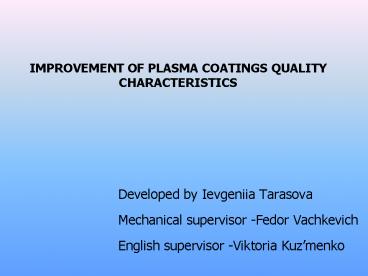IMPROVEMENT OF PLASMA COATINGS QUALITY CHARACTERISTICS - PowerPoint PPT Presentation
1 / 14
Title:
IMPROVEMENT OF PLASMA COATINGS QUALITY CHARACTERISTICS
Description:
IMPROVEMENT OF PLASMA COATINGS QUALITY ... Applications areas Plasma spray coating is becoming more widely used in industry to protect a variety of ... – PowerPoint PPT presentation
Number of Views:308
Avg rating:3.0/5.0
Title: IMPROVEMENT OF PLASMA COATINGS QUALITY CHARACTERISTICS
1
IMPROVEMENT OF PLASMA COATINGS QUALITY
CHARACTERISTICS
- Developed by Ievgeniia Tarasova
- Mechanical supervisor -Fedor Vachkevich
- English supervisor -Viktoria Kuzmenko
2
The main idea of the present work is to develop
plasma coating formulations and their application
technology that will allow to achieve maximal
performance characteristics.
3
Applications areas
- Plasma spray coating is becoming more widely
used in industry to protect a variety of parts
and tools from wear, corrosion and erosion
4
Plasma coating is the one obtained by applying
molten metal particles on a previously prepared
surface using a plasma jet.
5
Improvement of plasma coating quality
characteristics is held in the following areas
- activities to improve the quality by
pretreatment of powders and protected surface - activities for coatings quality improvement
during the process of spraying (technological
regimes optimization) - activities for coatings quality improvement by
treating surfaces after their formation
6
Technological parameters that influence
coatings formation and micro-asperities hight
are
- spraying distance
- spraying angle of a pneumatic gun
- abrasive particle size
- air pressure
- powder consumption
- speed of burner
7
Influence of dispersion distance (L) and slope
angle of pneumogun (a) on the micro unevenness
height(R?)
Table1
R?10-4? R?10-4? R?10-4? R?10-4? R?10-4?
L ?? a30? a45? a60? a90? Note
50 54-56 57-59 63-66 71-74 Got at permanent air pressure, diameter of nozzle of 510-3m and the abrasive size 0,510-3m
75 56-58 63-65 72-74 86-89 Got at permanent air pressure, diameter of nozzle of 510-3m and the abrasive size 0,510-3m
100 58-60 65-68 75-77 93-96 Got at permanent air pressure, diameter of nozzle of 510-3m and the abrasive size 0,510-3m
125 56-58 62-64 71-73 86-90 Got at permanent air pressure, diameter of nozzle of 510-3m and the abrasive size 0,510-3m
150 54-56 56-58 64-66 77-99 Got at permanent air pressure, diameter of nozzle of 510-3m and the abrasive size 0,510-3m
8
Influence of abrasive size (µ) and air pressure
(?) on the micro unevenness height (R?)
Table2
R?10-4? R?10-4? R?10-4? R?10-4?
µ10-3? ?0,2??? ?0,4??? ?0,6??? Note
0,1 43-45 50-52 56-57 Information is got at the distance L0,10m, nozzle diameter of 510-3m, the slope angle a90o
0,2 52-54 60-63 69-71 Information is got at the distance L0,10m, nozzle diameter of 510-3m, the slope angle a90o
0,3 60-62 71-73 81-84 Information is got at the distance L0,10m, nozzle diameter of 510-3m, the slope angle a90o
0,4 63-71 81-83 94-96 Information is got at the distance L0,10m, nozzle diameter of 510-3m, the slope angle a90o
0,5 76-79 93-96 106-109 Information is got at the distance L0,10m, nozzle diameter of 510-3m, the slope angle a90o
0,6 84-87 101-104 118-120 Information is got at the distance L0,10m, nozzle diameter of 510-3m, the slope angle a90o
9
The table data (tabl.1 and tabl. 2) analysis
showed that
- with reduction of slope angle of pneumogun to the
surface of detail the surface roughness also
reduses at permanent distance from pneumogun to
the detail and identical compressed air pressure - the increase of abrasive particles size results
in the increase of roughness at permanent
compressed air pressure - reduction of compressed air pressure results in
the reduction of roughness at the identical
abrasive particles size.
10
Mathematical method of prediction experiment
- Fig.1 Influence of technological parameters of
the plasma setting work on eventual properties of
coverages. - ?1 current strength(?)
- ?2 tension on an arc (?)
- ?3 expense of plasma-forming gas of
argon (l/mine) - ???D? is the compromise region of the
criteria ?1, ?2, ?3, ?4 - FGDE is optimal spraying region of thermal
coverages.
11
In order to improve the coatings quality it is
recommended to apply plasma and micro-plasma
melting
?)
b) c)
Fig.2 Structure of sprayed coverage from the
SNGN alloy after melting a in a stove with a
low oxidizing atmosphere b currents of
high-frequency c micro-plasma burner. ? 200
?)
12
Conclusion
- 1. The analysis of surface preparation approach
used before spraying gave an opportunity to
choose pnuematical surface preparation by means
of electrolytic as the most efficient one since
it allows to adjust the surface roughness in a
wider range. - 2. Mathematical investigation made it possible
to create the range of criteria compromising by
means of graphical-analytical approach. Moreover
it allowed to make optimal range of gas-termal
spraying. - 3. Among all the investigated methods of surface
melting aimed on quality improvement it is
advisable to implement plasma and microplasma
melting as it makes possible to achieve tight and
strong coupling of protection layers of steel and
titan. - All the investigations held in the research work
allowed to develop technical tutorials used for
producing improved quality features plasma
surfaces.
13
- THANKS FOR ATTENTION
14
(No Transcript)































